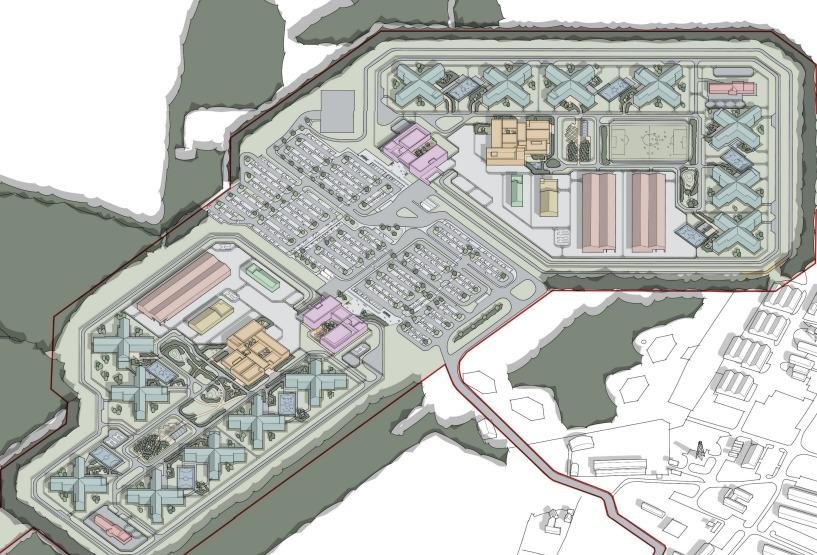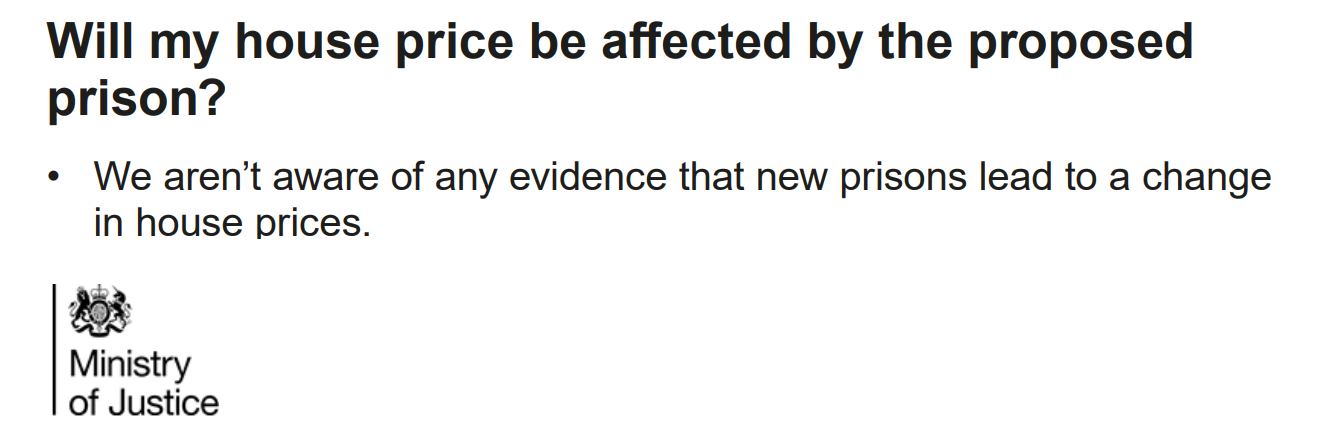
Mega Prisons
Local Amenities
The site is remote, over 9 miles from the nearest A road, more than 9 miles from the nearest train station and 23 miles from the motorway. The proposals take no account of the area’s distance from courts and local services required to rehabilitate prisoners. There is infrequent public transport to the villages and a shortage of potential prison service recruits as the Three Fields area has one of the lowest unemployment rates in Essex.
Environmental Impacts
The MoJ acknowledges that the prisons are likely to have significant effects on the environment. These include not only the visual impact of two Mega prisons but wider damage to local ecology, landscape and heritage assets, as well as a massive increase in road traffic.
The MOJ claims that these impacts can be controlled and mitigated effectively through the planning process but provides no valid basis for this.
The proposal is in direct opposition to UK Government, County council and District council climate initiatives and cannot be considered a sustainable development, as defined by the National Planning Policy Framework.
Road Infrastructure
Literally thousands of additional HGVs, vans and cars for construction, staff, deliveries and visitors will be squeezing down narrow B roads, over single lane bridges and past dozens of listed buildings and several primary schools. The area would suffer dramatically from damage to buildings and bridges and see an increase the number of road traffic accidents.
With no option to widen the roads due to listed bridges and buildings, the impact will be severe. Read about some traffic facts of a prison half the size here
Planning Policy
The MoJ’s proposal contradicts both local and national planning policies. The MoJ’s own professional advisers Cushman & Wakefield even admit this in their scoping report.
The prisons proposal even fails to comply with the MoJ’s own policies which state that new prisons should be sited in urban areas close to health facilities and with easier access for inmates’ families to facilitate better rehabilitation.
What will the prisons look like?
This would be the largest prison complex ever built in Europe with over 1,000 car park spaces, 20 metre high buildings, requiring 24-hour bright security lighting. The prisons’ air, noise, water and light pollution will have a major effect on the local natural and built environment and the health and well-being of residents in several nearby local villages, including Shalford, Great Bardfield, Toppesfield and Finchingfield, one of the most attractive in the country.
The proposed category B and C prisons would hold approximately 1,715 inmates each, making it up to 3,430 inmates across both.
Take a look at this video of Five Wells prison. The Ministry of Justice plan to use Five Wells as the basis for all their new prison designs. What do you think of it?
How will the prisons affect me?
There are many potential impacts from the proposed Mega Prisons development. Here we talk about a few that could affect local residents directly.
Traffic
A large asylum centre will require meals three times a day, laundry services, maintenance and staff, as well as the transport of asylum seekers to and from the facility. It won't be as large as two Mega Prisons, but it will require a vastly significant increase in traffic on roads not suitable for large volume of daily vehicular movements.
The Mega Prisons proposal includes a 1,000-space car park between the two prisons. With the requirement of service vehicles, food deliveries and maintenance vehicles, as well as employee shift changes, there could be over three thousand vehicle journeys a day to and from the facility.
The additional traffic will cause localised pollution, the possibility of congestion as vehicles struggle to pass each other in Finchingfield and Wethersfield (single lanes due to parked cars, Bardfield and Finchingfield bridge and the narrow roads in Silver Street, Wethersfield).
Most worrying though will be the prospect of an increase in road traffic accidents. The Wethersfield to Braintree road has 97 bends in a 7 mile stretch of road and in 1960 when the base was last fully active, they conclusively proved that the majority of road traffic accidents in our area happened on this stretch of road.
Somehow the MoJ believes they can mitigate these factors. However, unless they start demolishing the listed buildings that line our roads or widening the bridges in Bardfield and Finchingfield, there is nothing they can do to improve our road network that was already dangerous for large volumes of vehicles in the 1960’s.
Safety for Families and Security of Property
Whilst there is no doubt that the security of the MoJ’s new prison design will be high tech and fit for purpose, it’s not just the prisoners absconding you have to consider. Smuggling contraband into prisons is a huge problem for the MoJ. Nearly 50% of inmates said it’s easy to get illegal drugs in prison.
In most cases, it is the visitors to the inmates, or even staff members who facilitate the smuggling of phones, drugs and money into the prisons. Some of the visitors who have friends that are incarcerated will be leading the same life of crime, but without any restriction on their movement. It is those “visitors” who would be in the local area, looking to exploit any weaknesses in the prisons’ security.
Listen to the radio snippet taken from a show discussing the Wethersfield prison proposal. An almost identical prison scenario is described and the caller highlights an increase in local crime from undesirables being attracted to the area.
House Pricing
The official MoJ stance on house pricing being affected in the local area is one of deniability.
The MoJ has been furnished with an opinion from a highly respected RICS registered local estate agent with over 30 years experience in their field of expertise. It is their opinion that some residents within the proximity of the Prisons, will suffer a loss of value to their properties of 25%.
The caller on the radio snippet above also confirms house prices were “slashed” as a direct result of a smaller prison built in Shropshire.
Online estate agent Housesimple conducted a survey and concluded that more than a third of prospective homebuyers are willing to live by a prison - but of this number, half say the property would need to be discounted by 31% or more.
Opinion of local estate agent with over 30 years experience
How will the prisons affect the environment?
-
During their construction and operating phases, large scale building developments have a direct impact on our daily lives, health and well-being through the air that we breathe and a long-term impact on our children through their effect on greenhouse gas (GHG) emissions. The construction industry is a major source of pollution, responsible for around 4% of particulate emissions, more water pollution incidents than any other industry and thousands of noise complaints every year.
-
Construction pollutes the air through land clearance, operation of diesel engines, demolition, burning, and working with toxic materials. High levels of microscopic dust containing traces and particles of concrete, cement, wood, stone, sulphates and silica can be spread over several miles. Construction sites can also release carbon monoxide, carbon dioxide, nitrous oxide, hydrocarbons and noxious vapours from oils, glues, thinners, paints, treated woods, plastics, cleaners and other hazardous chemicals into the atmosphere. Although these emissions are invisible to the naked eye, their effects can be insidious. They can penetrate deeply into the lungs and cause a wide range of health problems, including respiratory illness, asthma, bronchitis and even cancer.
Although some reductions are possible, the fact remains the cement sector still accounts for 7 percent of global GHG emissions. If the global cement sector was a country, it would be the 3rd largest emitter in the world.
“Close to a quarter of energy-related global greenhouse gas (GHG) emissions are generated by the transport sector”.
-
One thing we all notice when we find ourselves outside a large city, is the darkness of the night sky. Apart from being able to see the stars better on a clear night, why does that matter? Well, the simple answer is that wildlife looks at the sky too but is far more likely to be adversely affected by changes in light levels. Even during the day, some building materials can be mistaken for water. How do we put an ‘offset value’ on that?
-
The noise from a construction site and road traffic are fairly obvious but we often ignore the impact it has on our lives and well-being. Not only is noise annoying and distracting but it can cause a range of cause health problems including hearing loss, high blood pressure, sleep disturbance and stress and not only for humans. Research suggests that high noise levels disturb the natural cycles of animals and forces them to migrate to new habitats.
-
Sources of water pollution on building sites include: diesel and oil; paint, solvents, cleaners and other harmful chemicals; and construction debris and dirt. When land is cleared and construction begins, it causes soil erosion and run-off of water containing silt, diesel, oil, toxic chemicals, and building materials like cement. Once these pollutants enter natural waterways, they destroy aquatic life and harm any wild or farm animal that drinks from them. Pollutants on construction sites can also soak into the groundwater, a source of human drinking water. Once contaminated, groundwater is much more difficult to treat than surface water.
-
Local roads often flood and suffer road closures because of the local infrastructure. Further runoff from an enormous construction site will make flooding and thus road closures a more frequent occurrence.
What are the alternatives?
The MoD is obliged to get best possible value when it sells any of its estate, and because there are alternatives to the prisons that are better for everyone, the MoD should be willing to enter into negotiations with a variety of potential buyers; but under Whitehall procurement rules, other government departments have the first opportunity to acquire land that is surplus to another government department’s requirements before it is offered to an external buyer or returned to the original landowners (under Crichel Down rules). It is imperative first to stop the MoJ proposal so that the future of the entire airfield can be opened up for discussion.
Click the button below to read about some of the sustainable alternatives and opportunities we have available.




